In the final days of May 2020, residents of Erie, Kansas, received a letter in the mail from their city government. The self-addressed envelope contained just one question: “Do you support the City of Erie purchasing Stub’s Market?”
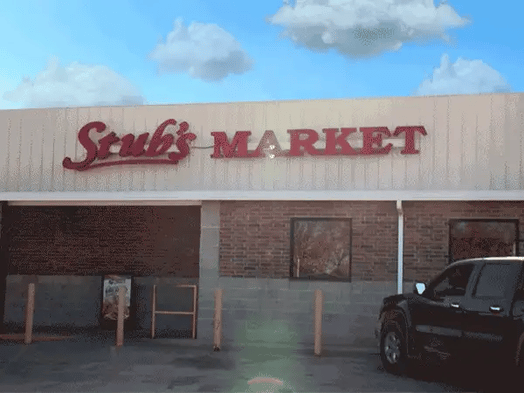
It was a dire moment for residents of Erie, a town of ~1k people in southeastern Kansas. COVID-19 was raging, basic household items and food products were running out of stock, and Stub’s Market — the city’s only grocery store — was on the verge of closing for good.
That would have left Erie with only a Dollar General, a chain store with a poor selection of produce and fresh food. To find fresh meats and vegetables, residents — many of whom don’t have cars — would’ve needed to travel 10 to 20 miles out of town.
So, the city council decided it would do just about anything to keep its only grocery store open.
In the subsequent weeks, responses to the poll began to trickle into the Erie City Council. 311 households in Erie responded. Of those, the vast majority, 213 people (68.5%), voted yes.
What followed is a rare feat of community activism. To keep Stub’s Market from shuttering, the city government decided to buy it out.
How Erie got its grocery store
Erie has all the quaint charm one might expect to find in a small, middle-America town.
Its main attractions include a park with dinosaurs made from junk metal and the public library. Each July, it hosts an annual soldiers’ reunion where residents cook beans in cast-iron pots over open fires, watch fireworks, and admire antique cars.
At one time, Erie had a thriving farming community. But today, the town’s core industry has largely disappeared.
“Really there’s not a lot of good jobs here,” Julie Kent, the director of Erie’s public library, told The Hustle.
Though some farming jobs still exist, many people drive outside of town for work, most often to an airplane-parts manufacturer in the nearby town of Chanute.
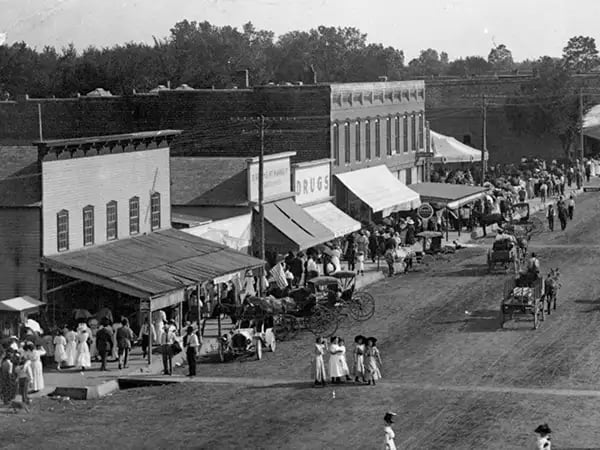
The main street of Erie, Kansas, circa 1906 (Kansas Historical Society)
Like many other small towns, Erie’s population waned in tandem with the decline of farming. Between 1980 and 2020, the town’s official head count fell by 26%, to 1,047 residents.
This population collapse had cascading impacts on local businesses in the city. With a shrinking pool of customers to serve, local stores struggled to turn a profit.
That was especially true for Erie’s grocery stores.
The first warning signs occurred in 2012, when the city’s only grocery store, G&W Foods, abruptly closed because it was losing so much money.
For two months, Erie didn’t have a single grocery store. Residents who couldn’t drive out of town depended on frozen meals from Dollar General. Getting fresh fruit and vegetables suddenly hinged on knowing someone who could make a delivery for them.
The city convinced Stub’s Market, which had previously occupied the location, to reopen its store before the end of the year.
It worked, but only for a few years. The owners of Stub’s were looking to retire, and they couldn’t run Erie’s grocery store much longer. In the late 2010s, they put their store on sale — but no one was willing to buy it.
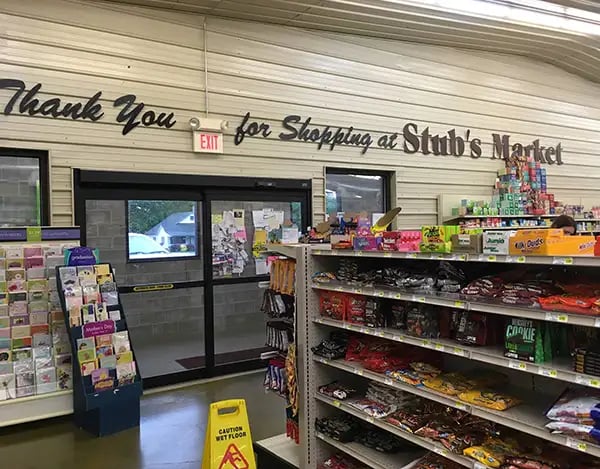
Stub’s Market, Erie’s only grocery store at the time (Facebook)
It was an intractable problem that Cindy Schoenhofer, the treasurer of Erie, learned about quickly.
Schoenhofer, who works part-time for the city and part-time as a controller at a local nursing home, knew Erie couldn’t afford to let Stub’s Market go. Losing a grocery store would lead to much worse problems down the line. If there was no place in town to buy produce, future residents might not move there.
“Like all small towns, if you lose your school, then you sort of lose your town,” Schoenhofer said. “The grocery store is similar. If you lose that, then you don’t have people shopping in town.”
Finally, in August 2019, Shirlene Mahurin, one of the co-owners of Stub’s Market, met with the Erie City Council to discuss an audacious proposal.
Instead of waiting for a private buyer to materialize, she asked, what if the city bought the store?
America’s rural grocery store problem
Across the US, countless rural towns are confronting the same dilemma as Erie. Between 1990 and 2015, rural non-metro counties lost 39% of their grocery stores, according to a report by the USDA.
Central to the problem is the fact that grocery stores run on razor-thin margins, especially in rural areas.
A 2020 survey of Minnesota grocery stores in towns of under 2.5k people found that the average profit was just 1.1%. That means even the slightest change — inflation, say, or rising costs from supply chain delays — can quickly erase any earnings.
Even the biggest chains, like Kroger, earn just a little over 2 cents for every dollar spent, but they can make up for it with their volume of sales. Small-town stores don’t have that luxury.
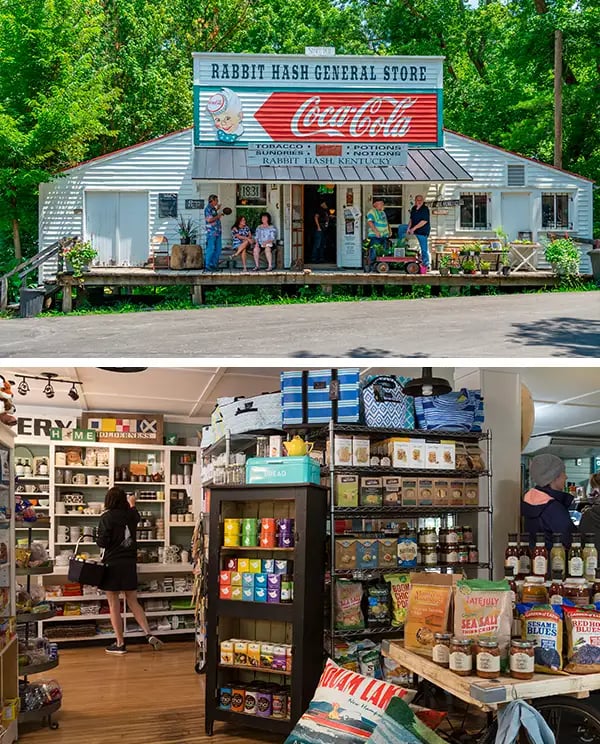
Rural grocery stores face challenges across the US (top: Historic Rabbit Hash General Store in Rabbit Hash, Kentucky; Jim Lane/Getty Images; bottom: Squam Lake Inn and Marketplace, Holderness, NH; Jumping Rocks/Getty Images)
Plenty of broader trends are forcing independent grocery stores to shutter, too:
1. Dollar stores and supercenters
The share of grocery stores in rural areas that are independent fell from 87% to 82%, thanks to the encroachment of chain stores.
As independent grocery stores disappear, supercenters are taking their place: The USDA found a 237% increase in the number of supercenters in these rural counties between 1990 and 2015. But many of these stores, especially dollar stores, don’t have fresh food.
2. Depopulation
Between 2010 and 2020, the number of Americans living in rural areas fell by .6%.
“When there are fewer people in town, you just have fewer people that can support that business,” said Erica Blair, the program manager of the Rural Grocery Initiative, a group that also advised Erie.
3. Succession crises
In Kansas, the average grocery store owner is 57 years old, according to Justin Carter, a senior project manager at the Center for Rural Affairs, “and they’re having a lot of trouble finding new owners.”
Carter says the failure to secure a new generation of owners has caused many rural grocery stores to close. “You’re getting a situation where the current group of store owners are retiring and just nobody’s taking over the store.”
To keep their stores from shuttering, some communities are applying a range of creative solutions:
- Community-owned stores: When Hay Springs, Nebraska (pop. 600) lost its only grocery store in 2019, local advocates began pamphleting to convince residents to buy out the store as a collective. The Farm to Family Cooperative opened in 2021.
- Self-serve stores: In Evansville, Minnesota (pop. ~700), residents had to drive 40 miles to get many of their groceries. One couple opened Main Street Market, a 24-hour self-serve grocery store accessible via an annual subscription of $75/year.
- Public-private partnerships: Often, cities might agree to cover a grocery store’s rent in order to help it cut costs. In West Baltimore, for instance, the nonprofit grocery Fresh at the Avenue operates out of a city-owned building.

Scenes from Erie, Kansas (Julie Kent)
Erie’s approach — to turn its grocery store into a publicly funded enterprise — is far less common.
But it certainly isn’t a stand-alone case.
The St. Paul model
When the city of Erie was considering the proposal to buy Stub’s Market, the first thing Schoenhofer did was reach out to Erie’s neighbor: St. Paul, Kansas (pop. 543).
St. Paul is one of the only other places in the country — along with Baldwin Market in Baldwin, Florida (pop: ~1.5k) and Caney Market (pop: ~1.8k) in Caney, Kansas — that accomplished what Erie was trying to do.
The story of St. Paul dates back to 2005, when a man named Rick Giefer became mayor.
The city hadn’t had a full-scale grocery store since 1985, and Giefer decided to change that. In 2008, he used city funding to get a new store, St. Paul Supermarket, off the ground. In 2013, when the couple who ran the store was staring down retirement, Giefer convinced the city to buy it outright.
In 2019, Schoenhofer drove to St. Paul to meet with that city’s clerk, who gave her some tips. The experiment, Schoenhofer found, had been a success. The St. Paul grocery employs ~15 people, and it turns a profit of 3%, slightly better than the average for rural grocery stores.
It has also kept people — and spending money — in town. Similarly, in Erie, residents show up to Erie Market for fresh lunches, like a BBQ pulled-pork sandwich or a taco on Taco Tuesday.
Other positive developments have followed. Erie just opened a new daycare center, a new restaurant, and a new coffee shop. “Once the ball started rolling, we started getting people saying, well, we could do this and we could do this,” Kent said.
By the fall of 2020, after collecting feedback from residents, the City of Erie had agreed to purchase Stub’s Market. The cost: $300k, plus the cost of inventory (~$100k) and a 0.5% cut to the store’s previous owners for the next 10 years — in total, less than ~$500k.
At the start of 2021, the city became the official owner of the store. The city council renamed it Erie Market, and it hired a manager with retail experience to run the store on the city’s behalf.
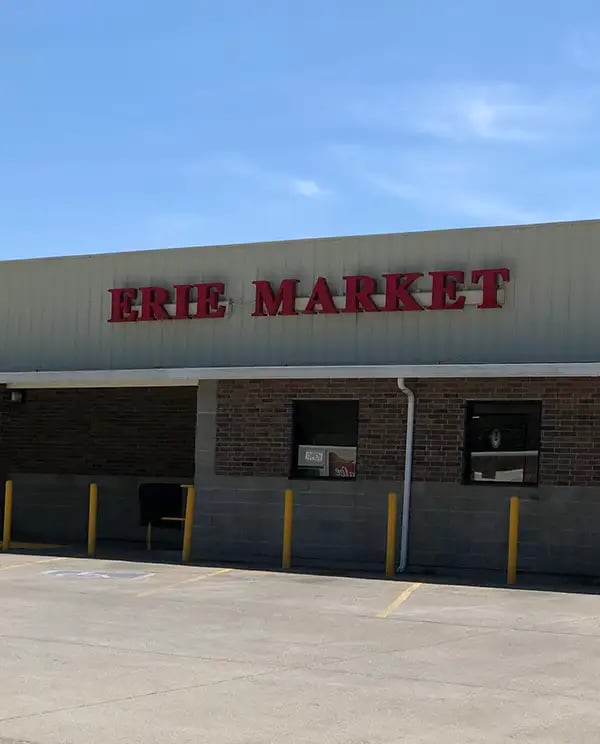
Erie’s only grocery store stayed alive — with a new name (Julie Kent)
So far, the City of Erie has taken a mostly hands-off approach to running Erie Market. The store manager submits a monthly report to the city about the finances. Erie will only step in if it slips into the red.
“We run it as a utility, like we do the electric bill and the water bill,” Schoenhofer said. Just like a water bill, if the costs of running the store goes up, Erie would add a small amount — less than $5 per month — to each resident’s utility bill to make up the difference.
Erie hasn’t had to do that yet, but rising inflation is making the city council nervous. Erie Market’s food suppliers are charging more on wholesale orders, and the store is passing some of the increased cost on to customers.
But when it comes to inflation, running the store as a public utility has an upside. According to Schoenhofer, the city council is looking into reducing the markup it adds to the groceries it sells.
Erie Market, after all, needs to break even, not make a huge profit. Its first priority is getting residents in the door.

